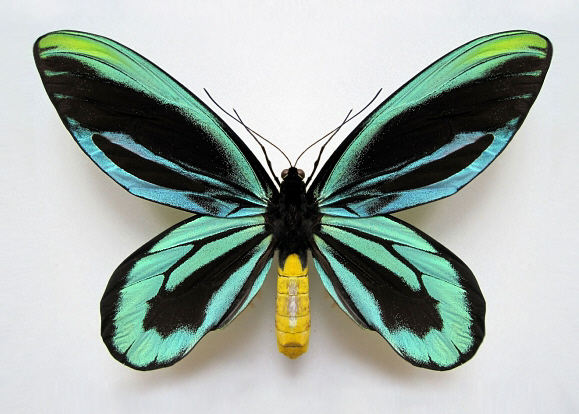
Introduction
The genus Ornithoptera (regarded by some authors as a subgenus of Troides) comprises of some of the largest and most magnificent butterflies on Earth. There are 13 species, the commonest and most widespread of which is priamus which is found in the Moluccas, West Irian, Papua New Guinea, the Solomon islands and northern Australia.
The female of the Alexandra Birdwing Ornithoptera alexandrae is the largest butterfly in the world, with a wingspan in excess of 30cms (12″). The British Natural History Museum contains the original specimen of this species which was shot (!) down from a tree and bears the evidence in the form of several holes in the badly damaged wings.
Another famous species is Ornithoptera croesus, a creature so stunningly beautiful that it inspired the legendary explorer and naturalist Alfred Russell Wallace to write the following:
“During my very first walk into the forest at Batchian, I had seen sitting on a leaf out of reach, an immense butterfly of a dark colour marked with white and yellow spots. I could not capture it as it flew away high up into the forest, but I at once saw that it was a female of a new species of Ornithoptera or “bird-winged butterfly,” the pride of the Eastern tropics.I was very anxious to get it and to find the male, which in this genus is always of extreme beauty. During the two succeeding months I only saw it once again, and shortly afterwards I saw the male flying high in the air at the mining village. I had begun to despair of ever getting a specimen as it seemed so rare and wild; till one day, about the beginning of January, I found a beautiful shrub with large white leafy bracts and yellow flowers, a species of Mussaenda, and saw one of these noble insects hovering over it, but it was too quick for me, and flew away.The next day I went again to the same shrub and succeeded in catching a female, and the day after a fine male. I found it to be as I had expected, a perfectly new and most magnificent species, and one of the most gorgeously coloured butterflies in the world. Fine specimens of the male are more than seven inches across the wings, which are velvety black and fiery orange, the latter colour replacing the green of the allied species.The beauty and brilliancy of this insect are indescribable, and none but a naturalist can understand the intense excitement I experienced when I at length captured it. On taking it out of my net and opening the glorious wings, my heart began to beat violently, the blood rushed to my head, and I felt much more like fainting than I have done when in apprehension of immediate death. I had a headache the rest of the day, so great was the excitement produced by what will appear to most people a very inadequate cause.”
Ornithoptera alexandrae is endemic to Papua New Guinea.
Habitats
This species is the rarest of the Ornithoptera species. It is confined to a tiny area of the Popondetta valley in Papua New Guinea, where past volcanic events laid down rich phosphates that enabled the larval foodplants of alexandrae – the vines Pararistolochia dielsiana and P. schlecteri to flourish.
Ornithoptera alexandrae is under continual threat from encroaching oil palm plantations. Another major threat is illegal butterfly collecting, as this species can trade on the black market for as much as USD15,000 per pair.
Lifecycle
Females lay a total of between 20-30 eggs in their lifetime. The eggs are blue and are laid singly on leaves of the foodplants. The fully grown larva is black with long curved thorn-like tubercles. These are bright red, apart from a central pair which are cream in colour. The huge chrysalis is green at first, later turning brown, and finally yellow as the body colour of the adult butterfly develops within. It looks remarkably like a twisted leaf, and is attached vertically to a stem or to the underside of a large leaf, supported by a long silken girdle. The adults emerge in early morning and take about an hour to fully expand and dry their wings. They live for about 3 months.
Adult behaviour
Males patrol through their forest territories each morning, searching the undergrowth for freshly emerged virgin females. They aggressively defend their domain from other intruding males, and will even chase away quite large birds. When a female is located the male hovers above her, releasing pheromones which are wafted over her to induce copulation. The pair remain joined for about 2 hours after which the female incubates the eggs for 2 or 3 days before looking for oviposition sites. Thereafter both sexes fly in the mornings and again in late afternoon. They nectar at Hibiscus, Mussaenda and other flowers which are large enough to support their weight. Nevertheless these butterflies which can weigh as much as 12 grams have to constantly flutter their wings to maintain their position over the flowers while nectaring.
